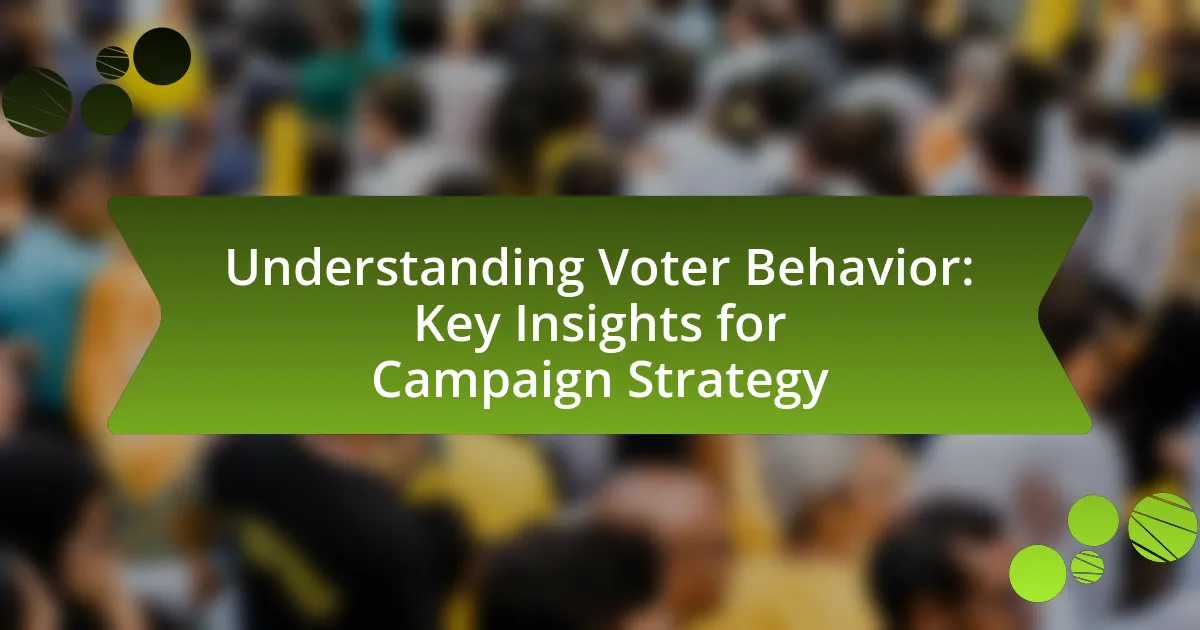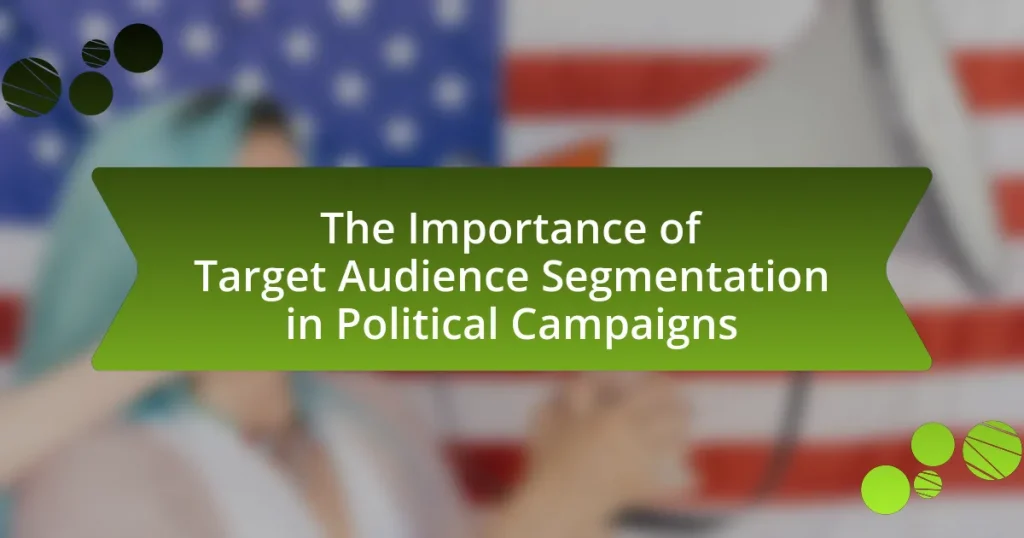Voter behavior encompasses the actions and decisions individuals make during elections, influenced by demographics, political ideology, social identity, and external events. Key factors affecting voter decisions include socioeconomic status, emotional appeals, and campaign strategies, which can significantly sway preferences and turnout. Understanding these behaviors is crucial for effective campaign planning, as it allows for targeted messaging and outreach that resonate with specific voter demographics. The article explores the complexities of voter behavior, its impact on election outcomes, and best practices for campaigns to engage voters effectively.
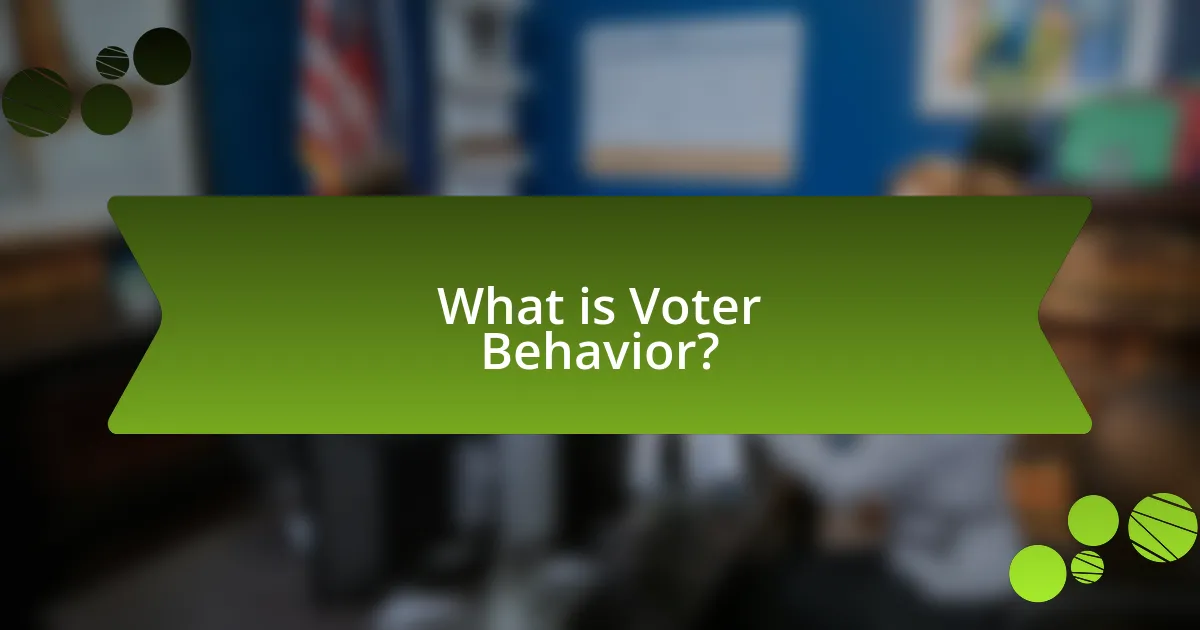
What is Voter Behavior?
Voter behavior refers to the actions and decisions of individuals when participating in elections, including how they choose candidates and their motivations for voting. This behavior is influenced by various factors such as demographics, political ideology, social identity, and external events. Research indicates that voter turnout can be affected by socioeconomic status, with higher education levels often correlating with increased participation in elections. Additionally, studies show that emotional appeals and campaign strategies can significantly sway voter preferences, highlighting the importance of understanding these behaviors for effective campaign planning.
How do we define voter behavior in the context of elections?
Voter behavior in the context of elections is defined as the actions and decisions made by individuals when participating in the electoral process. This behavior is influenced by various factors, including demographics, political ideology, social identity, and external events. Research indicates that voter turnout can be affected by socioeconomic status, with higher education levels correlating with increased participation rates. For instance, the U.S. Census Bureau reported that in the 2020 presidential election, 66.8% of eligible voters participated, reflecting a significant engagement influenced by factors such as the political climate and voter mobilization efforts.
What factors influence individual voter decisions?
Individual voter decisions are influenced by a combination of personal, social, and contextual factors. Personal factors include demographics such as age, gender, income, and education level, which shape political preferences and engagement. Social factors encompass peer influence, family opinions, and community norms that can sway voter attitudes. Contextual factors involve the political environment, including the economy, current events, and campaign strategies, which can significantly impact voter sentiment. Research indicates that these factors interact dynamically; for instance, a study by the Pew Research Center found that economic conditions can alter voter priorities, leading to shifts in support for candidates based on their perceived ability to address those issues.
How does voter behavior vary across different demographics?
Voter behavior varies significantly across different demographics, influenced by factors such as age, race, gender, education, and income. For instance, younger voters tend to lean more towards progressive candidates, while older voters often support conservative policies. According to the U.S. Census Bureau, in the 2020 presidential election, 50% of voters aged 18-29 supported Joe Biden, compared to 47% of those aged 65 and older who favored Donald Trump. Additionally, racial demographics play a crucial role; Black voters overwhelmingly supported Biden at 87%, while white voters were more divided, with 57% voting for Trump. Gender also impacts voting patterns, as women have shown a tendency to favor Democratic candidates, with 57% voting for Biden compared to 43% for Trump. Education levels further influence voter preferences, with college-educated individuals more likely to support Democrats. These demographic trends highlight the complexity of voter behavior and its implications for campaign strategies.
Why is understanding voter behavior crucial for campaign strategies?
Understanding voter behavior is crucial for campaign strategies because it enables campaigns to tailor their messages and outreach efforts effectively. By analyzing factors such as demographics, voting history, and social influences, campaigns can identify key voter segments and address their specific concerns. For instance, research from the Pew Research Center indicates that understanding the motivations and preferences of different voter groups can significantly enhance voter engagement and turnout. This targeted approach not only maximizes resource allocation but also increases the likelihood of winning elections by resonating with the electorate’s values and priorities.
How can insights into voter behavior improve campaign messaging?
Insights into voter behavior can significantly enhance campaign messaging by tailoring communication strategies to resonate with specific voter demographics and preferences. By analyzing data on voter motivations, concerns, and engagement patterns, campaigns can craft messages that address the unique needs and values of different segments. For instance, research from the Pew Research Center indicates that understanding issues prioritized by voters, such as healthcare or the economy, allows campaigns to focus their messaging on these topics, increasing relevance and impact. This targeted approach not only improves voter engagement but also enhances the likelihood of mobilizing support, as evidenced by successful campaigns that utilized data-driven strategies to connect with their audiences effectively.
What role does voter behavior play in election outcomes?
Voter behavior significantly influences election outcomes by determining which candidates or parties receive support. This behavior encompasses factors such as demographics, political ideology, and social influences, which collectively shape voter preferences. For instance, according to the Pew Research Center, demographic factors like age, race, and education level can lead to distinct voting patterns, impacting the overall results of elections. Additionally, studies show that voter turnout, driven by motivation and engagement, directly correlates with election outcomes; higher turnout often favors certain parties or candidates. Thus, understanding voter behavior is crucial for predicting and strategizing around election results.
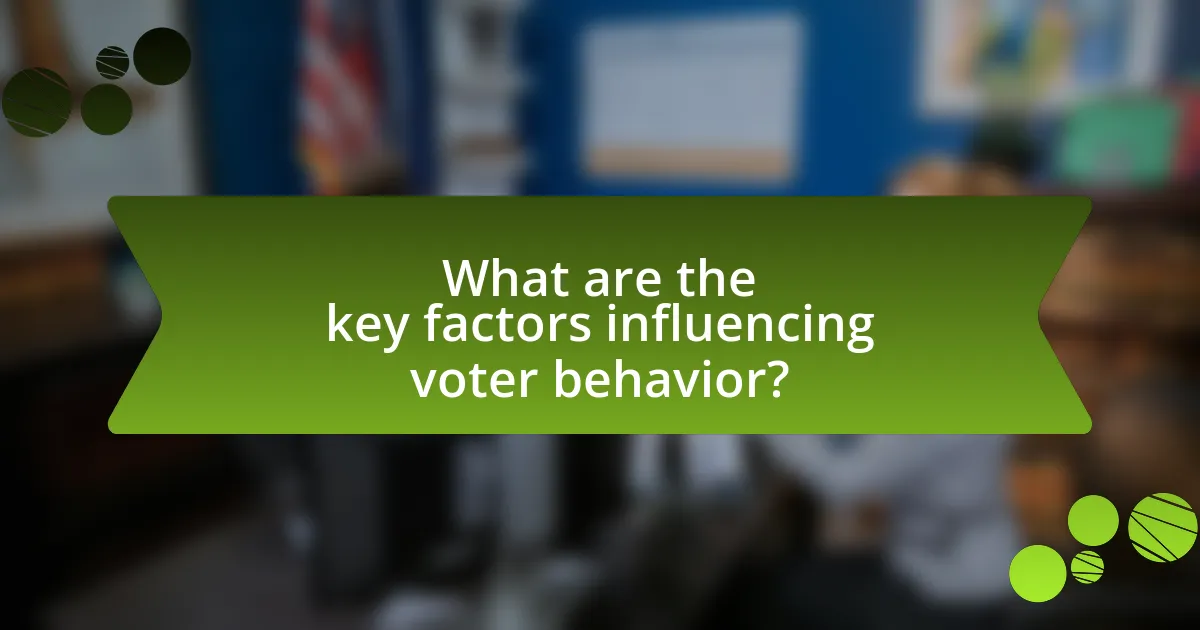
What are the key factors influencing voter behavior?
Key factors influencing voter behavior include demographics, political ideology, socioeconomic status, and media influence. Demographics such as age, gender, and ethnicity significantly shape voting preferences; for instance, younger voters tend to lean more liberal, while older voters often favor conservative candidates. Political ideology plays a crucial role, as individuals align their votes with parties that reflect their beliefs on issues like healthcare and education. Socioeconomic status affects voter turnout and candidate preference, with higher-income individuals generally supporting different policies than lower-income voters. Media influence, including social media and news outlets, shapes public perception and can sway opinions, particularly during election cycles. Studies have shown that these factors collectively determine voting patterns and outcomes in elections.
How do psychological factors affect voter choices?
Psychological factors significantly influence voter choices by shaping perceptions, attitudes, and decision-making processes. For instance, cognitive biases, such as confirmation bias, lead voters to favor information that aligns with their pre-existing beliefs, impacting their candidate preferences. Additionally, emotional appeals in campaign messaging can evoke feelings of trust or fear, swaying voters’ opinions and choices. Research by the American Psychological Association indicates that voters are more likely to support candidates who resonate with their values and emotions, demonstrating the critical role of psychological factors in electoral behavior.
What impact do emotions have on voting decisions?
Emotions significantly influence voting decisions by shaping voters’ perceptions and preferences. Research indicates that emotional responses to candidates, issues, and events can lead to increased engagement and motivation to vote. For instance, a study published in the journal “Political Psychology” by Brader (2006) found that emotionally charged campaign messages, particularly those eliciting fear or enthusiasm, can sway voter opinions and turnout. This demonstrates that emotions not only affect individual choices but also play a crucial role in the overall electoral process.
How does cognitive bias shape voter perceptions?
Cognitive bias significantly shapes voter perceptions by influencing how individuals interpret information and make decisions. For instance, confirmation bias leads voters to favor information that aligns with their pre-existing beliefs while dismissing contradictory evidence. This phenomenon can be observed in electoral contexts where voters selectively engage with media that supports their preferred candidates, reinforcing their views and potentially skewing their understanding of issues. Research by the Pew Research Center indicates that individuals are more likely to trust news sources that reflect their political leanings, further entrenching their biases and affecting their voting behavior.
What role does social influence play in voter behavior?
Social influence significantly shapes voter behavior by affecting individuals’ perceptions, attitudes, and decisions regarding political candidates and issues. Research indicates that social networks, including family, friends, and community groups, play a crucial role in informing voters and swaying their opinions. For instance, a study published in the American Political Science Review found that individuals are more likely to vote in alignment with their social circles, demonstrating the impact of peer pressure and social norms on electoral participation. Additionally, social media platforms amplify these influences by facilitating the rapid spread of information and opinions, further reinforcing group dynamics in voting behavior.
How do peer groups and family affect voting decisions?
Peer groups and family significantly influence voting decisions by shaping individuals’ political beliefs and preferences. Research indicates that socialization within these groups often leads to shared values and attitudes towards political issues, which can directly affect voting behavior. For instance, a study by the Pew Research Center found that individuals are more likely to align their voting choices with those of their family members and close friends, particularly during formative years. This alignment occurs because discussions within these social circles reinforce certain viewpoints and create a sense of community around shared political ideologies. Additionally, family dynamics, such as parental influence, can establish foundational political orientations that persist into adulthood, further solidifying voting patterns.
What is the impact of social media on voter behavior?
Social media significantly influences voter behavior by shaping opinions, increasing political engagement, and facilitating information dissemination. Research indicates that platforms like Facebook and Twitter serve as primary sources of political information for many voters, with 62% of Americans reporting that they get news from social media (Pew Research Center, 2020). This exposure can lead to increased voter turnout, as social media campaigns often mobilize users through targeted messaging and peer influence. Additionally, social media allows for real-time interaction between candidates and voters, fostering a sense of community and urgency around political issues.
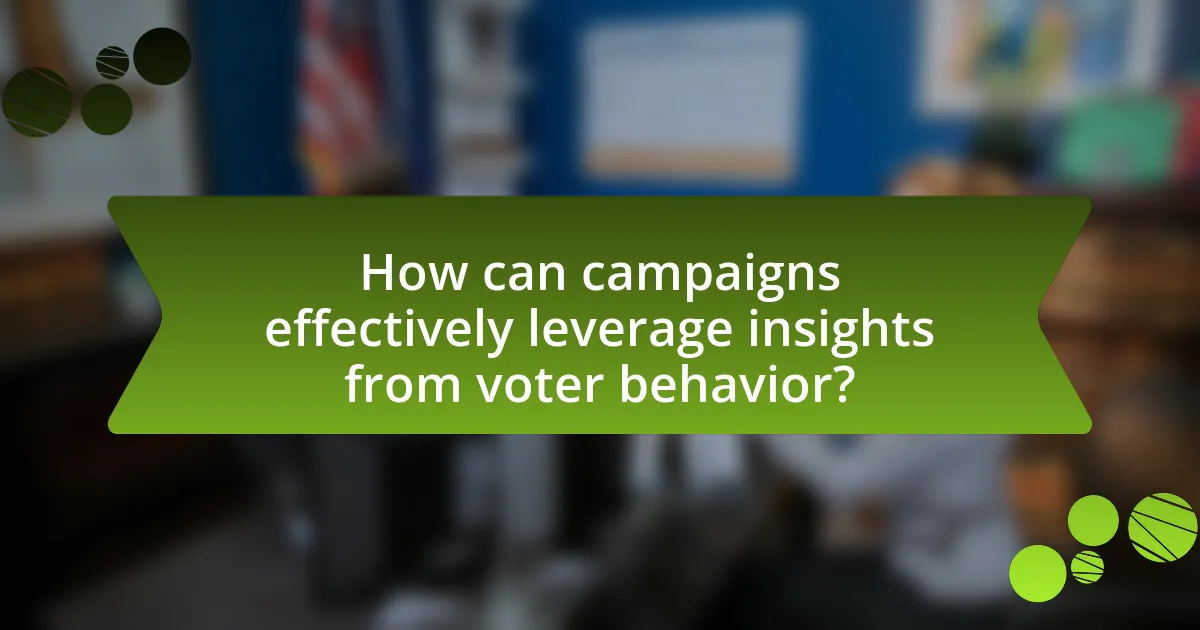
How can campaigns effectively leverage insights from voter behavior?
Campaigns can effectively leverage insights from voter behavior by utilizing data analytics to identify trends and preferences among different voter demographics. By analyzing past voting patterns, surveys, and social media interactions, campaigns can tailor their messaging and outreach strategies to resonate with specific groups. For instance, a study by the Pew Research Center found that targeted messaging based on demographic insights can increase voter engagement by up to 20%. This data-driven approach allows campaigns to allocate resources more efficiently, focusing on key issues that matter to voters, thereby enhancing their chances of success.
What strategies can campaigns use to engage voters based on behavior insights?
Campaigns can engage voters based on behavior insights by utilizing targeted messaging, personalized outreach, and data-driven engagement strategies. Targeted messaging involves analyzing voter demographics and preferences to tailor communication that resonates with specific groups, thereby increasing relevance and impact. Personalized outreach can include direct interactions through phone calls, texts, or emails that address individual voter concerns, which has been shown to enhance voter connection and response rates. Data-driven engagement strategies leverage analytics to identify voter behavior patterns, allowing campaigns to optimize their outreach efforts and allocate resources effectively. For instance, research indicates that campaigns employing data analytics can increase voter turnout by up to 10%, demonstrating the effectiveness of these strategies in mobilizing voters.
How can targeted messaging improve voter turnout?
Targeted messaging can improve voter turnout by delivering personalized information that resonates with specific demographics, thereby increasing engagement. Research indicates that tailored communication strategies, such as those based on demographic data and voting history, can significantly enhance voter mobilization efforts. For instance, a study by the Pew Research Center found that voters who received messages aligned with their interests and concerns were 20% more likely to participate in elections compared to those who received generic messages. This demonstrates that targeted messaging effectively addresses the unique motivations of different voter groups, leading to higher turnout rates.
What are effective methods for mobilizing specific voter demographics?
Effective methods for mobilizing specific voter demographics include targeted outreach, tailored messaging, and leveraging community influencers. Targeted outreach involves identifying and engaging with specific groups through data analysis, ensuring that campaign efforts are focused on demographics that are likely to support the candidate or cause. Tailored messaging is crucial; campaigns should craft messages that resonate with the values and concerns of each demographic, as evidenced by research showing that personalized communication increases voter engagement. Additionally, leveraging community influencers, such as local leaders or organizations, can enhance credibility and reach, as studies indicate that endorsements from trusted figures significantly impact voter turnout.
What common mistakes should campaigns avoid regarding voter behavior?
Campaigns should avoid underestimating the importance of voter engagement and failing to tailor their messages to specific demographics. Research indicates that campaigns that do not actively engage with voters or understand their unique concerns often see lower turnout rates. For instance, a study by the Pew Research Center found that personalized outreach significantly increases voter participation, highlighting the necessity for campaigns to connect with voters on issues that matter to them. Additionally, campaigns should not ignore the impact of misinformation; studies show that voters exposed to false information are less likely to participate in elections, emphasizing the need for accurate communication.
How can misinterpretation of voter behavior lead to campaign failures?
Misinterpretation of voter behavior can lead to campaign failures by causing candidates to misalign their strategies with the actual preferences and priorities of the electorate. When campaigns rely on inaccurate assumptions about what voters value, they may focus on issues that are not significant to their target audience, resulting in a disconnect that can diminish voter engagement and support. For instance, a campaign that overestimates the importance of economic issues in a demographic that prioritizes social justice may fail to resonate, leading to lower turnout and support. Historical examples, such as the 2016 U.S. presidential election, illustrate how misreading voter sentiment in key swing states contributed to unexpected outcomes, highlighting the critical need for accurate voter behavior analysis in campaign strategy.
What are the risks of over-relying on data analytics in understanding voter behavior?
Over-relying on data analytics in understanding voter behavior can lead to significant risks, including misinterpretation of data, neglect of qualitative insights, and overgeneralization of voter motivations. Misinterpretation occurs when data is taken out of context, leading to erroneous conclusions about voter preferences. For instance, a campaign may focus solely on demographic data without considering cultural or social factors that influence voter decisions. Neglecting qualitative insights, such as personal narratives or community sentiments, can result in a lack of understanding of the emotional drivers behind voter behavior. Overgeneralization happens when campaigns assume that trends observed in data apply universally to all voters, ignoring the diversity within voter groups. These risks can ultimately lead to ineffective campaign strategies that fail to resonate with the electorate.
What best practices should campaigns follow to understand and engage voters?
Campaigns should utilize data analytics, targeted messaging, and community engagement to effectively understand and engage voters. Data analytics allows campaigns to gather insights on voter demographics, preferences, and behaviors, enabling them to tailor their strategies accordingly. For instance, using voter files and surveys can help identify key issues that resonate with specific voter segments. Targeted messaging, informed by this data, ensures that communications are relevant and impactful, increasing the likelihood of voter engagement. Additionally, community engagement through town halls, social media interactions, and grassroots initiatives fosters a sense of connection and trust between candidates and voters. Research from the Pew Research Center indicates that personalized communication significantly enhances voter turnout, demonstrating the effectiveness of these best practices.
